TOPIC 66 . The forming of of good

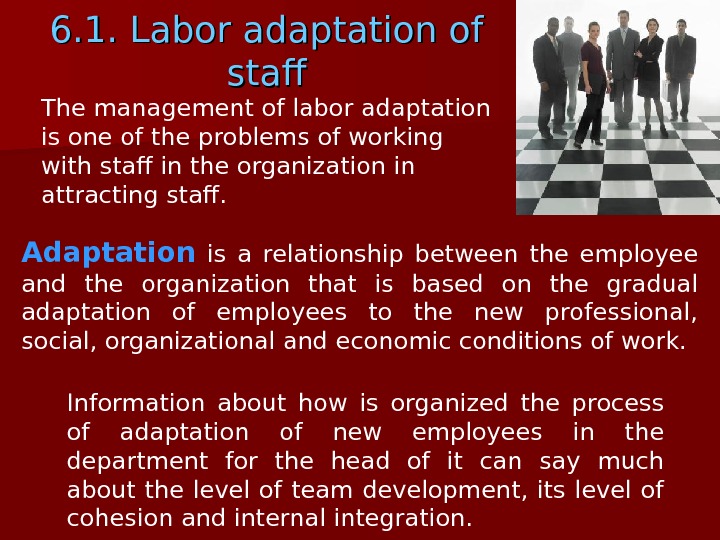
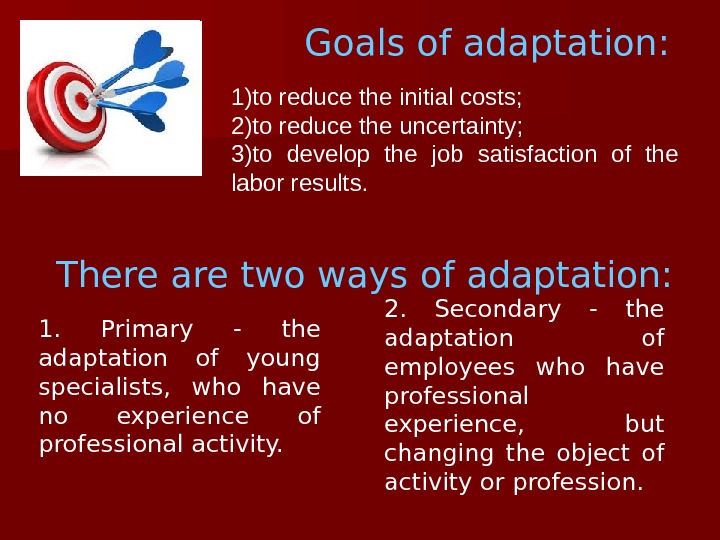
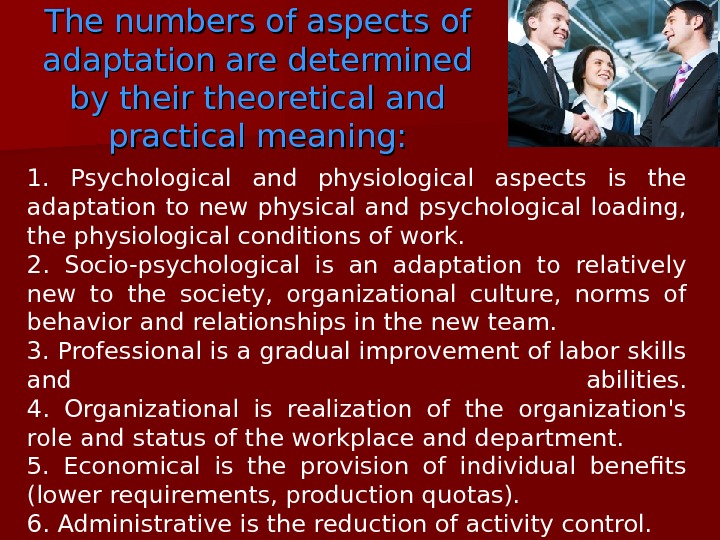
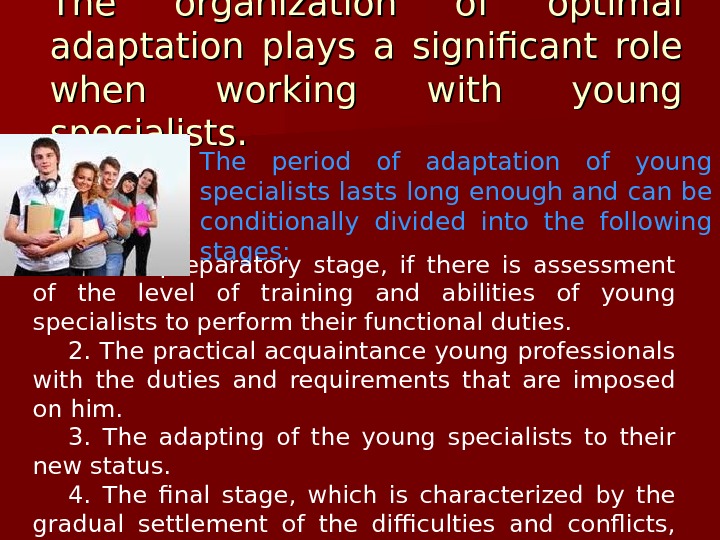
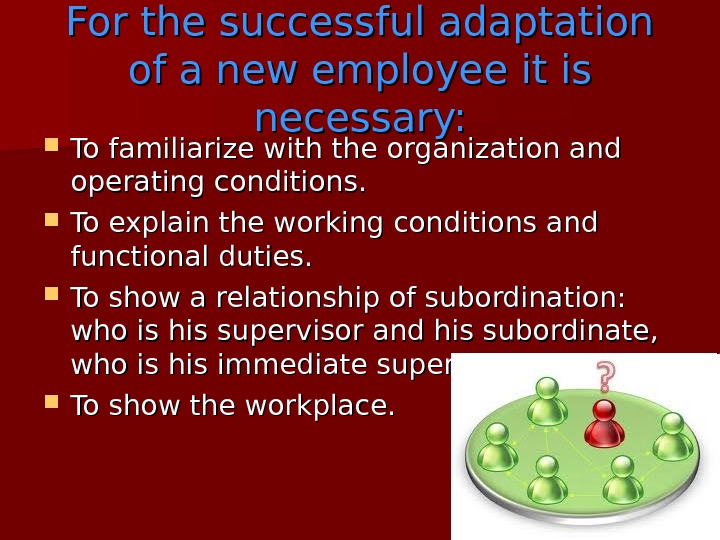
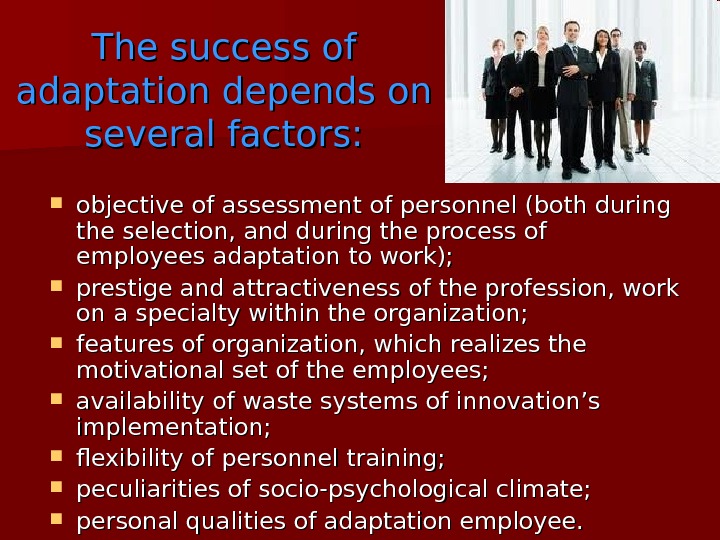


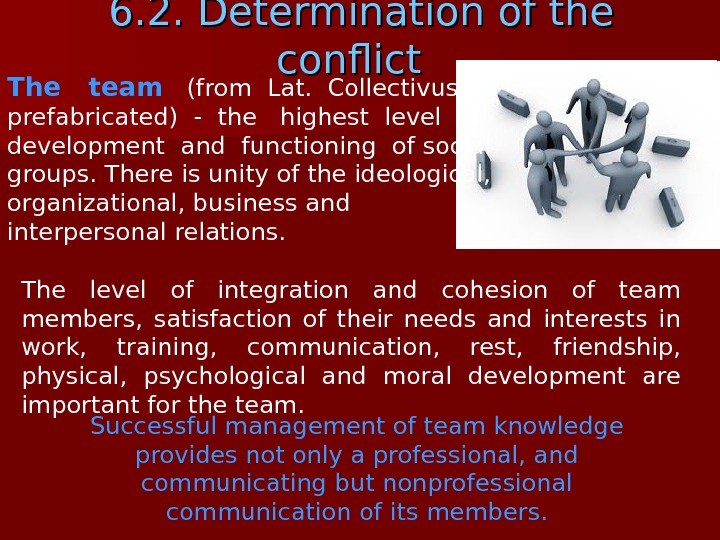

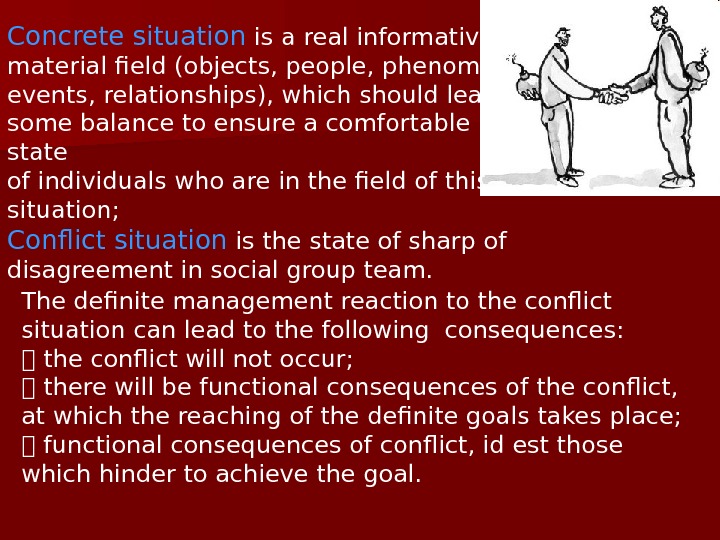
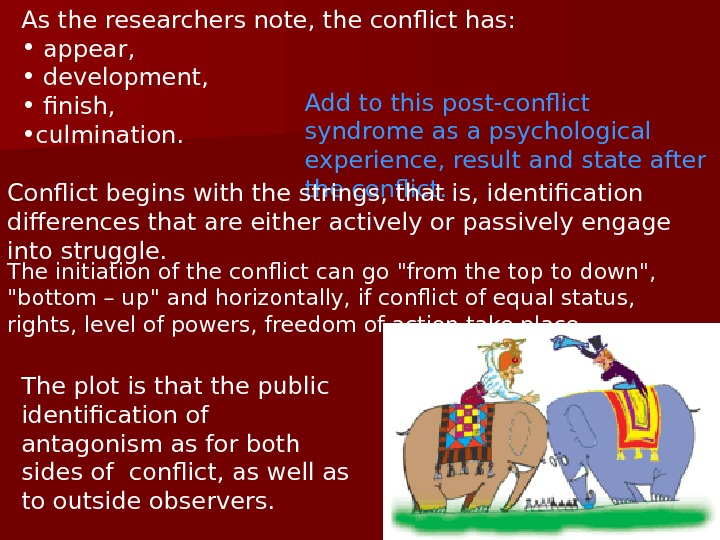

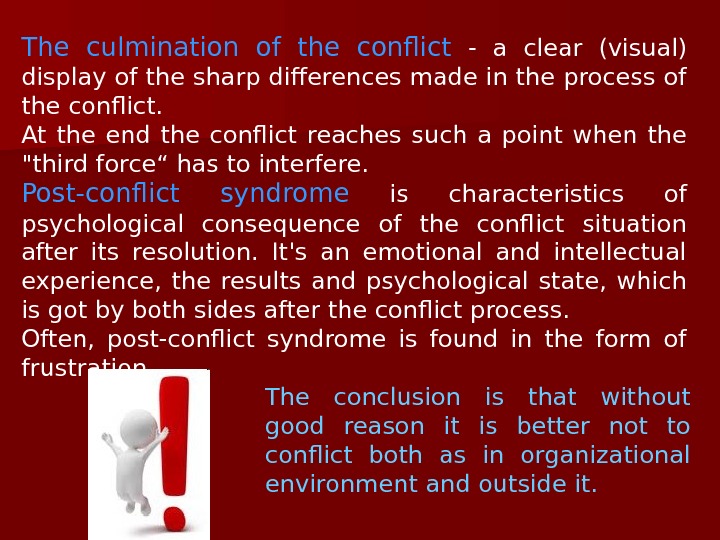
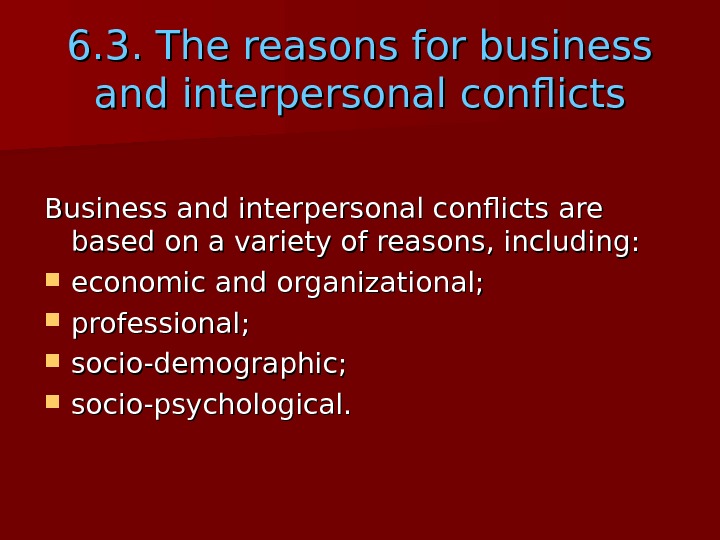
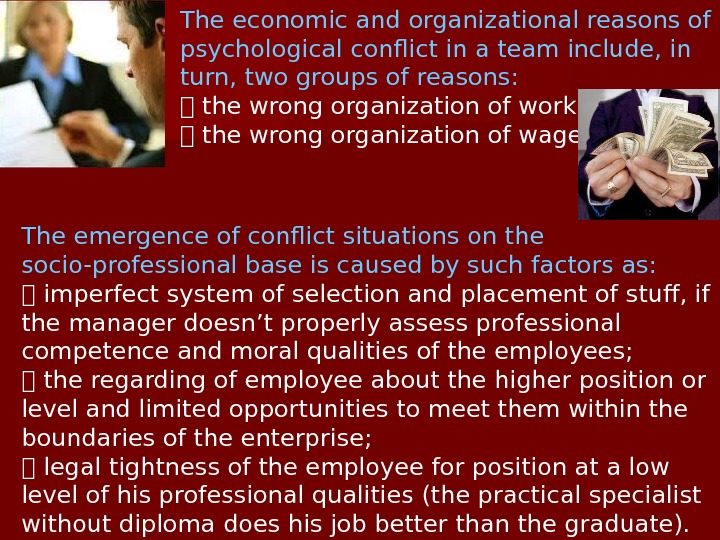


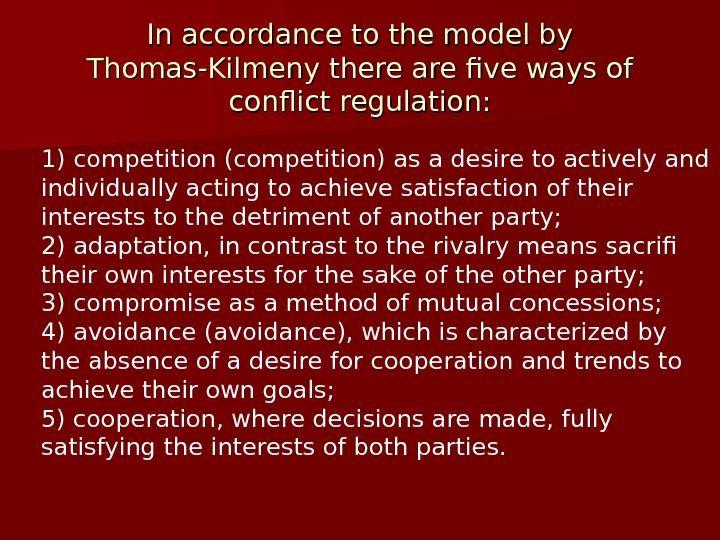
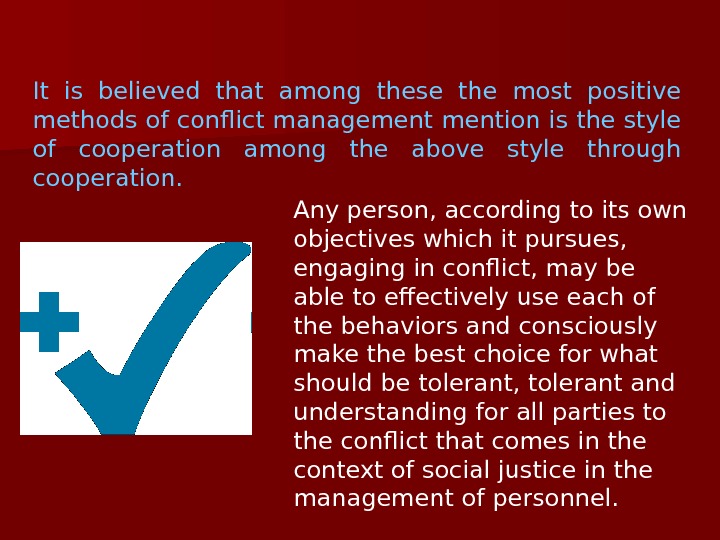

topic_6_the_forming_of_good_working_conditions.ppt
- Размер: 1.4 Mегабайта
- Количество слайдов: 22
Описание презентации TOPIC 66 . The forming of of good по слайдам
 TOPIC 66. The forming of of good working conditions 66. 1. Labor adaptation of staff 66. 2. Determination of the conflict 66. 3. The reasons for the business and interpersonal conflicts
TOPIC 66. The forming of of good working conditions 66. 1. Labor adaptation of staff 66. 2. Determination of the conflict 66. 3. The reasons for the business and interpersonal conflicts
 6. 1. Labor adaptation of staff Adaptation is a relationship between the employee and the organization that is based on the gradual adaptation of employees to the new professional, social, organizational and economic conditions of work. The management of labor adaptation is one of the problems of working with staff in the organization in attracting staff. Information about how is organized the process of adaptation of new employees in the department for the head of it can say much about the level of team development, its level of cohesion and internal integration.
6. 1. Labor adaptation of staff Adaptation is a relationship between the employee and the organization that is based on the gradual adaptation of employees to the new professional, social, organizational and economic conditions of work. The management of labor adaptation is one of the problems of working with staff in the organization in attracting staff. Information about how is organized the process of adaptation of new employees in the department for the head of it can say much about the level of team development, its level of cohesion and internal integration.
 Goals of adaptation: 1) to reduce the initial costs; 2) to reduce the uncertainty; 3) to develop the job satisfaction of the labor results. There are two ways of adaptation: 1. Primary — the adaptation of young specialists, who have no experience of professional activity. 2. Secondary — the adaptation of employees who have professional experience, but changing the object of activity or profession.
Goals of adaptation: 1) to reduce the initial costs; 2) to reduce the uncertainty; 3) to develop the job satisfaction of the labor results. There are two ways of adaptation: 1. Primary — the adaptation of young specialists, who have no experience of professional activity. 2. Secondary — the adaptation of employees who have professional experience, but changing the object of activity or profession.
 The numbers of aspects of adaptation are determined by their theoretical and practical meaning: 1. Psychological and physiological aspects is the adaptation to new physical and psychological loading, the physiological conditions of work. 2. Socio-psychological is an adaptation to relatively new to the society, organizational culture, norms of behavior and relationships in the new team. 3. Professional is a gradual improvement of labor skills and abilities. 4. Organizational is realization of the organization’s role and status of the workplace and department. 5. Economical is the provision of individual benefits (lower requirements, production quotas). 6. Administrative is the reduction of activity control.
The numbers of aspects of adaptation are determined by their theoretical and practical meaning: 1. Psychological and physiological aspects is the adaptation to new physical and psychological loading, the physiological conditions of work. 2. Socio-psychological is an adaptation to relatively new to the society, organizational culture, norms of behavior and relationships in the new team. 3. Professional is a gradual improvement of labor skills and abilities. 4. Organizational is realization of the organization’s role and status of the workplace and department. 5. Economical is the provision of individual benefits (lower requirements, production quotas). 6. Administrative is the reduction of activity control.
 The organization of optimal adaptation plays a significant role when working with young specialists. The period of adaptation of young specialists lasts long enough and can be conditionally divided into the following stages: 1. The preparatory stage, if there is assessment of the level of training and abilities of young specialists to perform their functional duties. 2. The practical acquaintance young professionals with the duties and requirements that are imposed on him. 3. The adapting of the young specialists to their new status. 4. The final stage, which is characterized by the gradual settlement of the difficulties and conflicts, and the transition to a stable work.
The organization of optimal adaptation plays a significant role when working with young specialists. The period of adaptation of young specialists lasts long enough and can be conditionally divided into the following stages: 1. The preparatory stage, if there is assessment of the level of training and abilities of young specialists to perform their functional duties. 2. The practical acquaintance young professionals with the duties and requirements that are imposed on him. 3. The adapting of the young specialists to their new status. 4. The final stage, which is characterized by the gradual settlement of the difficulties and conflicts, and the transition to a stable work.
 For the successful adaptation of a new employee it is necessary: To famili ariz e with the organization and operating conditions. To explain the working conditions and functional duties. To show a relationship of subordination: who is his supervisor and his subordinate, who is his immediate superior. To show the workplace.
For the successful adaptation of a new employee it is necessary: To famili ariz e with the organization and operating conditions. To explain the working conditions and functional duties. To show a relationship of subordination: who is his supervisor and his subordinate, who is his immediate superior. To show the workplace.
 The success of adaptation depends on several factors: objective of assessment of personnel (both during the selection, and during the process of employees adaptation to work); prestige and attractiveness of the profession, work on a specialty within the organization; features of organization, which realizes the motivational set of the employees; availability of waste systems of innovation’s implementation; flexibility of personnel training; peculiarities of socio-psychological climate; personal qualities of adaptation employee.
The success of adaptation depends on several factors: objective of assessment of personnel (both during the selection, and during the process of employees adaptation to work); prestige and attractiveness of the profession, work on a specialty within the organization; features of organization, which realizes the motivational set of the employees; availability of waste systems of innovation’s implementation; flexibility of personnel training; peculiarities of socio-psychological climate; personal qualities of adaptation employee.
 Personnel manager must use a specially designed program for the adaptation of new employees. The adaptation program is divided into general and specialized ones. The general program is addressed to the organization in whole and is directed to the following solution of issues: — a general idea about the organization: tendency’s of development, objectives, priorities, problems, traditions, products and customers, activities, structure, communication; payment for work in the organization; — fringe benefits: insurance, severance pay, sick care, pensions, opportunities for the training at work; — protection work and safety: preventive measures, rules of fire prevention and control, rules of conduct in case of accidents, health care and medical service and places of delivery of the first medical service; — the relations of employees with a trade unions , the terms and conditions of employment, assignment, transfer, promotion, rights and responsibilities of the employees, execution of trade unions judgments, discipline and punishment; — service life: food, rest rooms, other services.
Personnel manager must use a specially designed program for the adaptation of new employees. The adaptation program is divided into general and specialized ones. The general program is addressed to the organization in whole and is directed to the following solution of issues: — a general idea about the organization: tendency’s of development, objectives, priorities, problems, traditions, products and customers, activities, structure, communication; payment for work in the organization; — fringe benefits: insurance, severance pay, sick care, pensions, opportunities for the training at work; — protection work and safety: preventive measures, rules of fire prevention and control, rules of conduct in case of accidents, health care and medical service and places of delivery of the first medical service; — the relations of employees with a trade unions , the terms and conditions of employment, assignment, transfer, promotion, rights and responsibilities of the employees, execution of trade unions judgments, discipline and punishment; — service life: food, rest rooms, other services.
 This program covers the following issues: functions, goals and priorities of department, organization, structure and functions, relationships with other departments; duties and responsibilities; rule-disposition: the rule that the only inherent to this type of work or department; department review entrance and exit, smoking areas, a fire alarm button. After the realization of the general program of adaptation the specialized program of adaptation starts. It connected with any department or workplace. This program is carried out by line managers or mentors.
This program covers the following issues: functions, goals and priorities of department, organization, structure and functions, relationships with other departments; duties and responsibilities; rule-disposition: the rule that the only inherent to this type of work or department; department review entrance and exit, smoking areas, a fire alarm button. After the realization of the general program of adaptation the specialized program of adaptation starts. It connected with any department or workplace. This program is carried out by line managers or mentors.
 66. 2. Determination of the conflict The team (from Lat. Collectivus — prefabricated) — the highest level of development and functioning of social groups. There is unity of the ideological, organizational, business and interpersonal relations. The level of integration and cohesion of team members, satisfaction of their needs and interests in work, training, communication, rest, friendship, physical, psychological and moral development are important for the team. Successful management of team knowledge provides not only a professional, and communicating but nonprofessional communication of its members.
66. 2. Determination of the conflict The team (from Lat. Collectivus — prefabricated) — the highest level of development and functioning of social groups. There is unity of the ideological, organizational, business and interpersonal relations. The level of integration and cohesion of team members, satisfaction of their needs and interests in work, training, communication, rest, friendship, physical, psychological and moral development are important for the team. Successful management of team knowledge provides not only a professional, and communicating but nonprofessional communication of its members.
 Conflict (from Lat. Conflictus — clash) in a philosophy is an extreme intensification of disagreement, in the disciplines of socio-psychological orientation is a clash of persons, their ideas, interests, needs assessments, the level of ambitions, etc. The conflicts pervade all spheres of life of individuals and usually occur in any group. The following type of conflicts are distinguished : a) social; b) military; c) intellectual; d) Moral; d) intrapersonal; e) interpersonal; h) between groups.
Conflict (from Lat. Conflictus — clash) in a philosophy is an extreme intensification of disagreement, in the disciplines of socio-psychological orientation is a clash of persons, their ideas, interests, needs assessments, the level of ambitions, etc. The conflicts pervade all spheres of life of individuals and usually occur in any group. The following type of conflicts are distinguished : a) social; b) military; c) intellectual; d) Moral; d) intrapersonal; e) interpersonal; h) between groups.
 Concrete situation is a real informative material field (objects, people, phenomena, events, relationships), which should lead to some balance to ensure a comfortable state of individuals who are in the field of this situation; Conflict situation is the state of sharp of disagreement in social group team. The definite management reaction to the conflict situation can lead to the following consequences: the conflict will not occur; there will be functional consequences of the conflict, at which the reaching of the definite goals takes place; functional consequences of conflict, id est those which hinder to achieve the goal.
Concrete situation is a real informative material field (objects, people, phenomena, events, relationships), which should lead to some balance to ensure a comfortable state of individuals who are in the field of this situation; Conflict situation is the state of sharp of disagreement in social group team. The definite management reaction to the conflict situation can lead to the following consequences: the conflict will not occur; there will be functional consequences of the conflict, at which the reaching of the definite goals takes place; functional consequences of conflict, id est those which hinder to achieve the goal.
 As the researchers note, the conflict has: • appear, • development, • finish, • culmination. Add to this post-conflict syndrome as a psychological experience, result and state after the conflict. The plot is that the public identification of antagonism as for both sides of conflict, as well as to outside observers. Conflict begins with the strings, that is, identification differences that are either actively or passively engage into struggle. The initiation of the conflict can go «from the top to down», «bottom – up» and horizontally, if conflict of equal status, rights, level of powers, freedom of action take place.
As the researchers note, the conflict has: • appear, • development, • finish, • culmination. Add to this post-conflict syndrome as a psychological experience, result and state after the conflict. The plot is that the public identification of antagonism as for both sides of conflict, as well as to outside observers. Conflict begins with the strings, that is, identification differences that are either actively or passively engage into struggle. The initiation of the conflict can go «from the top to down», «bottom – up» and horizontally, if conflict of equal status, rights, level of powers, freedom of action take place.
 Conflict can develop explicit (declared) or hidden. Explicitly means the conflict that occurs if the sides did not reach about the disagreement. The hidden takes place unless the parties have stated their contradictions, but by the actions or non-verbal behavior can guess or know for sure that they are in conflict. The hid period of the conflict sooner or later becomes apparent or declared, if «the third force» does not interfere beforehand. The duration of the hidden period can not be predicted, since its transition into a clear state depends on the quantity number of «conflict energy» of the parties and the external stimulus, which destabilizes self-control.
Conflict can develop explicit (declared) or hidden. Explicitly means the conflict that occurs if the sides did not reach about the disagreement. The hidden takes place unless the parties have stated their contradictions, but by the actions or non-verbal behavior can guess or know for sure that they are in conflict. The hid period of the conflict sooner or later becomes apparent or declared, if «the third force» does not interfere beforehand. The duration of the hidden period can not be predicted, since its transition into a clear state depends on the quantity number of «conflict energy» of the parties and the external stimulus, which destabilizes self-control.
 The culmination of the conflict — a clear (visual) display of the sharp differences made in the process of the conflict. At the end the conflict reaches such a point when the «third force“ has to interfere. Post-conflict syndrome is characteristics of psychological consequence of the conflict situation after its resolution. It’s an emotional and intellectual experience, the results and psychological state, which is got by both sides after the conflict process. Often, post-conflict syndrome is found in the form of frustration. The conclusion is that without good reason it is better not to conflict both as in organizational environment and outside it.
The culmination of the conflict — a clear (visual) display of the sharp differences made in the process of the conflict. At the end the conflict reaches such a point when the «third force“ has to interfere. Post-conflict syndrome is characteristics of psychological consequence of the conflict situation after its resolution. It’s an emotional and intellectual experience, the results and psychological state, which is got by both sides after the conflict process. Often, post-conflict syndrome is found in the form of frustration. The conclusion is that without good reason it is better not to conflict both as in organizational environment and outside it.
 66. 3. The reasons for business and interpersonal conflicts Business and interpersonal conflicts are based on a variety of reasons, including: economic and organizational; professional; socio-demographic; socio-psychological.
66. 3. The reasons for business and interpersonal conflicts Business and interpersonal conflicts are based on a variety of reasons, including: economic and organizational; professional; socio-demographic; socio-psychological.
 The economic and organizational reasons of psychological conflict in a team include, in turn, two groups of reasons: the wrong organization of work; the wrong organization of wages. The emergence of conflict situations on the socio-professional base is caused by such factors as: imperfect system of selection and placement of stuff, if the manager doesn’t properly assess professional competence and moral qualities of the employees; the regarding of employee about the higher position or level and limited opportunities to meet them within the boundaries of the enterprise; legal tightness of the employee for position at a low level of his professional qualities (the practical specialist without diploma does his job better than the graduate).
The economic and organizational reasons of psychological conflict in a team include, in turn, two groups of reasons: the wrong organization of work; the wrong organization of wages. The emergence of conflict situations on the socio-professional base is caused by such factors as: imperfect system of selection and placement of stuff, if the manager doesn’t properly assess professional competence and moral qualities of the employees; the regarding of employee about the higher position or level and limited opportunities to meet them within the boundaries of the enterprise; legal tightness of the employee for position at a low level of his professional qualities (the practical specialist without diploma does his job better than the graduate).
 The essence of the socio-psychological reasons of conflict is psichotipological, moral and spiritual incompatibility of some team members (including the leader) in the presence and the absence of objective reasons for conflict. Socio-demographic reasons of conflict. In teams where there are representatives of all age groups and life orientations are balanced and even padded. If the age-old harmony is disturbed, there may be conflicts. Socio-psychological reasons of interpersonal conflict can be deceptive images, if no objective conflict situation, but the relationship of the parties mistakenly are considered as a conflict.
The essence of the socio-psychological reasons of conflict is psichotipological, moral and spiritual incompatibility of some team members (including the leader) in the presence and the absence of objective reasons for conflict. Socio-demographic reasons of conflict. In teams where there are representatives of all age groups and life orientations are balanced and even padded. If the age-old harmony is disturbed, there may be conflicts. Socio-psychological reasons of interpersonal conflict can be deceptive images, if no objective conflict situation, but the relationship of the parties mistakenly are considered as a conflict.
 The consequences can be differented depending on the content, participants and conditions of the conflict. 1. The complete elimination of mutual confrontation by reconciliation between the parties on a specific basis. 2. Withdrawal of the conflicting parties, or one of their outoff staff. 3. The disappearance of the confrontation, if one side emerges the winner and the other admits defeat. 4. The weakening of the conflict, if both parties are to some extent, satisfy its claims and go make some concessions to each other. 5. The disappearance of the opposition, if both sides lose and get the «negative» satisfaction. 6. «Transformation» of the conflict to another, modified or entirely new conflict , that the strength of their differences in background removes the original conflict. 7. The gradual decay of the conflict, due to a random move, if members and leaders do not take decisive measures to eliminate it. 8. Mechanical elimination of the conflict.
The consequences can be differented depending on the content, participants and conditions of the conflict. 1. The complete elimination of mutual confrontation by reconciliation between the parties on a specific basis. 2. Withdrawal of the conflicting parties, or one of their outoff staff. 3. The disappearance of the confrontation, if one side emerges the winner and the other admits defeat. 4. The weakening of the conflict, if both parties are to some extent, satisfy its claims and go make some concessions to each other. 5. The disappearance of the opposition, if both sides lose and get the «negative» satisfaction. 6. «Transformation» of the conflict to another, modified or entirely new conflict , that the strength of their differences in background removes the original conflict. 7. The gradual decay of the conflict, due to a random move, if members and leaders do not take decisive measures to eliminate it. 8. Mechanical elimination of the conflict.
 In accordance to the model by Thomas-Kilmeny there are five ways of conflict regulation: 1) competition (competition) as a desire to actively and individually acting to achieve satisfaction of their interests to the detriment of another party; 2) adaptation, in contrast to the rivalry means sacrifi their own interests for the sake of the other party; 3) compromise as a method of mutual concessions; 4) avoidance (avoidance), which is characterized by the absence of a desire for cooperation and trends to achieve their own goals; 5) cooperation, where decisions are made, fully satisfying the interests of both parties.
In accordance to the model by Thomas-Kilmeny there are five ways of conflict regulation: 1) competition (competition) as a desire to actively and individually acting to achieve satisfaction of their interests to the detriment of another party; 2) adaptation, in contrast to the rivalry means sacrifi their own interests for the sake of the other party; 3) compromise as a method of mutual concessions; 4) avoidance (avoidance), which is characterized by the absence of a desire for cooperation and trends to achieve their own goals; 5) cooperation, where decisions are made, fully satisfying the interests of both parties.
 Any person, according to its own objectives which it pursues, engaging in conflict, may be able to effectively use each of the behaviors and consciously make the best choice for what should be tolerant, tolerant and understanding for all parties to the conflict that comes in the context of social justice in the management of personnel. It is believed that among these the most positive methods of conflict managemention is the style of cooperation among the above style through cooperation.
Any person, according to its own objectives which it pursues, engaging in conflict, may be able to effectively use each of the behaviors and consciously make the best choice for what should be tolerant, tolerant and understanding for all parties to the conflict that comes in the context of social justice in the management of personnel. It is believed that among these the most positive methods of conflict managemention is the style of cooperation among the above style through cooperation.

